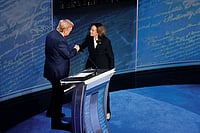That Aurangzeb was a complex personality eminently suited for dramatic portrayals was known even when he was alive. John Dryden, who was his contemporary, wrote an eponymous heroic play—Aureng-zebe—in 1675, in which he painted Aurangzeb as a prince who was prepared to sacrifice anything for the woman he loved. The fight for the throne is no doubt described in the play—“Darah from loyal Aureng-Zebe is fled/And forty thousand of his men lie dead”—but its plots and sub-plots, typical of a heroic play, obscure the real Aurangzeb.
Indira Parthasarathy’s play—Aurangzeb-Monarch and Man—written almost 300 years after Dryden, brings out a totally different Aurangzeb. Parthasarathy, now a fighting 94, and the Grand Old Man of modern Tamil literature, wrote the play in Tamil in 1974. It became an instant success and was translated into several languages. The Hindustani version of the play was directed by the redoubtable M K Raina and Raj Babbar played the role of Aurangzeb. There was an early English translation of the play in 1976, which appeared in the now defunct theatre magazine Enact.
This translation is by T Sriraman. It is to the credit of Sriraman that he brings out in his translation the urgency and the nuances of the Tamil version without sounding strange and ungainly.

The author’s Aurangzeb is not a lovelorn hero. Nor is he a mindless zealot. He is a man with a mission. He wants to make India into an indistinguishable whole. The India of his dream, as he himself says, will be ‘one country, one language and one religion’. At the very end of the play, he realises that he hasn’t achieved what he really wanted. He is shorn of all his arrogant sureties. “Am I religious fanatic? Or an orphan who constantly longed for love? What impelled me to commit all those murders? I have run my course … a tired old man who has played his part. I have become history.”
The play tells us that India is too complex a nation to be brought under the umbrella of uniformity. This was true during Aurangzeb’s time and during the terrible days of the Emergency when the Hindustani play was staged in Delhi. This is true even today and will be true in the future. The trouble is, men with vision usually end up on the horns of a dilemma, but the vision, more often than not, make the people, whom the visionaries lord over, undergo horrendous suffering.
The play has just four scenes, and the author has Aurangzeb appear only in the latter half of the play. But as the translator says in his introduction, his spirit pervades the play. Even in the very first scene, in a Shakespearean manner, two soldiers, both pious Muslims and spies of Aurangzeb, berate his brother—Prince Dara—for his esoteric views and gullibility. They are both sure that Aurangzeb, the upholder of true Islam, will outsmart him.
The play revolves mainly around five characters—Dara, Shahjahan, Jahanara, Roshanara and Aurangzeb. The cataclysmic events of those days—Shah Jahan’s dethronement, Dara’s execution and Aurangzeb’s accession to the throne—are all described in the words of the main characters. Shah Jahan keeps dreaming of a black Taj Mahal, which he wants to be built as his resting place right opposite the original one across the Yamuna River. He wants to avoid war at all costs and is prepared to partition the country between the four warring brothers—the other two being Murad and Shuja.

Dara, the eldest son, wants an India where every religion has the full freedom to function and hopes to get the support of the people, though he is not sure that he is strong enough to achieve his aim. Jahanara, the daughter of Shah Jahan, is fond of Dara and agrees with the plan of Shah Jahan to partition Hindustan. The other daughter, Roshanara, a devout Muslim, fully supports her pious brother. Aurangzeb, of course, is sure of himself, until the very last moment that is, when doubts begin to overpower him.
The dialogues are quite sharp and the repartees retain their bite. For example, this is a conversation between Shah Jahan, Jahanara and Dara, when Shah Jahan justifies another Mahal in black.
Shah Jahan: It is the dreams of individuals that sustain civilisation. The men who will look at these two mahals three hundred years hence will not care how many died of famine today. Shah Jahan carved two poems on stone—that is what they will say in their minds. Lo, there! I can see even at this moment waves of humanity surging for a view of these mahals.
Jahanara: To demand this sacrifice from men of the present so that someone in future can have the pleasure of viewing great art—what sort of political morality is that? Is there a difference between this and that dictum of Hinduism which says that we should turn this life into a veritable hell so that we can enjoy heavenly bliss in the next. Moreover …
Dara (intervening): Nowhere in Hindu religious philosophy does it say that we should make a hell of this life, sister. All that Hinduism says is that we must realise our full potential for growth in this life to realise the God within us—that should be the horizon of our growth.
But, as one earlier reviewer of the Hindustani version remarked, these wordy confrontations in the play come across as electoral lectures. Some of them are so modern that it is difficult to believe that they were uttered by the feudal lords of the 17th century. Nevertheless, the play’s core contemporaneity—that it is futile to search for a single solution to a complex puzzle called Hindustan—will be what will appeal to a reader or a watcher of the play. This will assure its perennial relevance.
(Views expressed are personal)
P A Krishnan is a well-known author both in English and Tamil

























